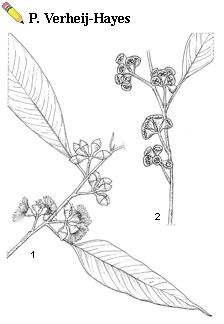Record Number
3512
PROSEA Handbook Number
5(1): Timber trees; Major commercial timbers
Taxon
Eucalyptus urophylla S.T. Blake
This article should be read together with the article on the genus: Eucalyptus in the Handbook volume indicated above in this database.
This article should be read together with the article on the genus: Eucalyptus in the Handbook volume indicated above in this database.
Protologue
Austrobaileya 1(1): 7 (1977).
Synonyms
Eucalyptus alba auct. non Reinw. ex Blume, Eucalyptus decaisneana auct. non Blume.
Vernacular Names
Timor white gum (En). Indonesia: ampupu (Timor). Vietnam: b[aj]ch d[af]n d[or].
Distribution
The Lesser Sunda Islands (Timor, Wetar, Flores, Adonara, Lomblem and Alor). Planted in many tropical parts of the world.
Uses
E. urophylla is an important source of heavy eucalypt timber. The wood is also used for pulp production, as a fuelwood and for charcoal production. The bark has a tannin content of over 10%.
Observations
A medium-sized to very large tree of up to 55 m tall, bole straight, up to 200 cm in diameter, bark rough, fissured, scaly-fibrous, reddish-brown or pearl-grey; juvenile leaves subopposite, ovate or elliptical, adult leaves alternate, straight to slightly falcate, narrowly to very narrowly ovate, 7-20 cm 0.7-3 cm, caudate-acuminate, discolorous, petiole 12-30 mm long; inflorescence axillary, simple, umbels 5-8-flowered; flower buds ellipsoid or obovoid, shortly acuminate, operculum equal or slightly longer than the calyx tube; fruit cup-shaped or obconical, 6-10 mm 7-12 mm, with 3 or 4 included or partly exserted valves. Eucalyptus urophylla occurs in open, often secondary montane forest and performs best on deep, moist, well-drained soils at (350-)500-3000 m altitude. Until 1977 Eucalyptus urophylla was not treated as a species distinct from Eucalyptus alba. As Eucalyptus alba has been widely cultivated throughout the world (also under the name Eucalyptus decaisneana) there is some confusion about the true nature of several provenances. The occurrence of hybrids between Eucalyptus alba and Eucalyptus urophylla as well as between the latter and Eucalyptus saligna or Eucalyptus tereticornis enhances the confusion.
Image
 | Eucalyptus urophylla S.T. Blake - 1, flowering branch; 2, fruiting branch |
Selected Sources
[16]Alrasjid, H. & Widiarti, A., 1987. Natural regeneration of ampupu (Eucalyptus urophylla S.T. Blake) in Gunung Mutis forest complex East Nusa Tenggara, Indonesia. Buletin Penelitian Hutan 489: 28–41.
[52]Becking, J.H., 1948. Korte beschrijving van de houtsoorten voor boscultuuren op Java en Madoera [Short description of wood species for forest plantations on Java and Madoera]. Bosbouwproefstation en Bosinrichting, Bogor. 115 pp.
[62]Blake, S.T., 1977. Four new species of Eucalyptus. Austrobaileya 1: 1–10.
[130]Chew, T.K., 1980. Growth of Eucalyptus species in Peninsular Malaysia. Malaysian Forester 43: 8–15.
[193]Doat, J., 1978. Les tannins dans les bois tropicaux [Tannins in tropical woods]. Bois et Forêts des Tropiques 182: 37–54.
[322a]Hillis, W.E. & Brown, A.G., 1978. Eucalypts for wood production. Griffin Press, Adelaide. 434 pp.
[343]Jacobs, M.R., 1981. Eucalypts for planting, 2nd ed. FAO Forestry Series No 11. FAO, Rome. 677 pp.
[540]Penfold, A.R. & Willis, J.L., 1961. The eucalypts: botany, cultivation, chemistry and utilisation. Hill, London. 551 pp.
[659]Suhaendi, H. & Djapilus, A., 1978. Pemilihan jenis-jenis Eucalytpus dalam'usaha reboisasi dan prospek pengembangannya di daerah-daerah [Selection of Eucalyptus species for reforestation work and prospects for growing them in various regions]. Lembaran Pengembangan No 2. Lembaga Penelitian Hutan, Bogor. iv + 40 pp.]
[715]Turnbull, J. & Brooker, I., 1978. Timor mountain gum, Eucalyptus urophylla S.T. Blake. Forest Tree Series No 214. CSIRO, Division of Forest Research, Melbourne. 2 pp.
[52]Becking, J.H., 1948. Korte beschrijving van de houtsoorten voor boscultuuren op Java en Madoera [Short description of wood species for forest plantations on Java and Madoera]. Bosbouwproefstation en Bosinrichting, Bogor. 115 pp.
[62]Blake, S.T., 1977. Four new species of Eucalyptus. Austrobaileya 1: 1–10.
[130]Chew, T.K., 1980. Growth of Eucalyptus species in Peninsular Malaysia. Malaysian Forester 43: 8–15.
[193]Doat, J., 1978. Les tannins dans les bois tropicaux [Tannins in tropical woods]. Bois et Forêts des Tropiques 182: 37–54.
[322a]Hillis, W.E. & Brown, A.G., 1978. Eucalypts for wood production. Griffin Press, Adelaide. 434 pp.
[343]Jacobs, M.R., 1981. Eucalypts for planting, 2nd ed. FAO Forestry Series No 11. FAO, Rome. 677 pp.
[540]Penfold, A.R. & Willis, J.L., 1961. The eucalypts: botany, cultivation, chemistry and utilisation. Hill, London. 551 pp.
[659]Suhaendi, H. & Djapilus, A., 1978. Pemilihan jenis-jenis Eucalytpus dalam'usaha reboisasi dan prospek pengembangannya di daerah-daerah [Selection of Eucalyptus species for reforestation work and prospects for growing them in various regions]. Lembaran Pengembangan No 2. Lembaga Penelitian Hutan, Bogor. iv + 40 pp.]
[715]Turnbull, J. & Brooker, I., 1978. Timor mountain gum, Eucalyptus urophylla S.T. Blake. Forest Tree Series No 214. CSIRO, Division of Forest Research, Melbourne. 2 pp.
Author(s)
C.C.H. Jongkind
Correct Citation of this Article
Jongkind, C.C.H., 1993. Eucalyptus urophylla S.T. Blake. In: Soerianegara, I. and Lemmens, R.H.M.J. (Editors): Plant Resources of South-East Asia No 5(1): Timber trees; Major commercial timbers. PROSEA Foundation, Bogor, Indonesia. Database record: prota4u.org/prosea

All texts are licensed under a Creative Commons Attribution-Noncommercial-Share Alike 3.0 Netherlands License
This license does not include the illustrations (Maps,drawings,pictures); these remain all under copyright.